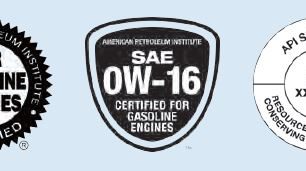Explaining Why European Oils
I wanted to keep some of these older post available as they contain some great technical information which is now difficult to find. These from from the older site.
New AMSOIL European Car Formula 5W-30 Synthetic
Motor Oil meets the latest Volkswagen specification,
VW 504.00/507.00 – Amsoil European AEL 5W30 (Available in 5-Liter Bottle)
Articles by AMSOIL’s Dan Peterson – VP. Technical Development

August 2013
Prior Tech Department article on European Oils and Market:
The European motor oil market has always been different from the North
American market. European engine oil drain intervals have consistently been
longer than those in the U.S., and oil formulations and additive packages
have also differed from those of North American engine oils. These differences are due primarily to European emissions legislation, fuel economy concerns and stringent severe-service oil durability requirements.
In the United States, oil classifications and requirements are developed
through a process involving a number of trade associations and organizations, and the classifications are finalized and managed by the American Petroleum Institute (API) and the International Lubricant Standardization and Approval Committee (ILSAC). In Europe, industry wide
specifications are developed by the Association des Constructeurs
Européens d ‘Automobiles (ACEA).
The API-governed engine oil specification has traditionally been the most
common in the U.S., and oils meeting current API specs are still widely used
today. More recently, ILSAC, which has a more global focus, is having a greater influence on North American specifications due to the rising number of Japanese vehicles sold in the U.S. As a result, the new ILSAC specification, GF-5, differs more from its API counterpart, SN, than in the past
ACEA does not have the recognition and influence in Europe that API does
in North America because individual vehicle manufacturers in Europe strongly support their own engine oil specifications.
As a result, there are a number of different widely used European engine
oil specifications, and oil manufacturers are tasked with building appropriate
engine lubes for each.
As these new European vehicles make their way to the U.S., consumers are
discovering they can’t necessarily use just any oil. One recognized example
of a very particular specification is Volkswagen VW 504.00/507.00 (504.00
covers gasoline engines, 507.00 covers diesel engines). This specialized engine oil specification was designed by VW to help protect emissions-reduction equipment and support proper operation and longevity of the vehicle. Until recently, AMSOIL did not offer a product meeting this specification, and there are only a handful of oils available in the U.S. that do.
New AMSOIL European Car Formula 5W-30 Synthetic Motor Oil (product code AEL) does meet the spec, as well as the ACEA A3/B4 specification, which was created with slightly different priorities than the VW
504.00/507.00 spec.
ACEA oils engineered for the A3/B4 category meet the requirements of
direct-injected gasoline and diesel engines in addition to the requirements
of A3/B3. In order to provide optimal performance in direct-injection diesel engines, an oil must be highly stable and durable; direct-injection systems
are notoriously hard on engine oil.
ACEA A3/B3 European oil specifications require stable, stay-in-grade engine oils to ensure these high-performance engines are protected from inadequate oil supply and excessive wear. For an oil to be considered stay-in-grade, it must resist thickening or thinning out of an established viscosity range. The table below outlines the general differences between four ACEA sequences for gasoline and light-duty diesel oils in regard to fuel economy benefits and drain interval recommendations.
Moving forward, Volkswagen plans to maintain three global engine oil specifications for its light-duty gasoline and diesel vehicles: VW 504.00/507.00, VW 502.00/505.01 and VW 501.01/505.00.
New AMSOIL European Car Formula 5W-30 Synthetic Motor Oil is recommended for Volkswagen vehicles requiring VW 504.00/507.00, while AMSOIL European Car Formula 5W-40 Synthetic Motor Oil is designed for Volkswagens requiring VW 502.00/505.00/505.01.
Both formulations are recommended for the ACEA A3/B4 specification, among others.
Fuel Economy Push on Manufactures You Need To Know
Emerging technologies will improve fuel economy and challenge lubricants. AMSOIL products can help avoid expensive repairs in this evolving market.
Most of you have heard about the changes in the Corporate Average Fuel Economy (CAFE) standards set by the Environmental Protection Agency (EPA) for cars and light trucks. The calculation for CAFE is somewhat complex, but according to the National Highway Traffic Safety Administration (NHTSA), the projected actual combined CAFE requirements for 2013 model-year vehicles will be 25.7 mpg. This is in contrast to the highly publicized improvement phases proposed over the next 12 years. The NHTSA projects the first phase, which covers 2017-2021, will result in a CAFE standard of 40.3-41.0 mpg. The second phase, which was recently announced, covers standards for 2022-2025 vehicle years with a projected CAFE of 48.7-49.7 mpg.
These changes are basically doubling fuel efficiency requirements over the next 12 years and forcing vehicle manufacturers to make fundamental changes in vehicle design to meet the standards. Everything is on the table, including incentives for “game-changing” technologies, like hybridization for full-size pickup trucks. Fully electric and hybrid vehicles will become a bigger part of manufacturers’ offerings. These fundamental changes in power train technology will have a bigger footprint in future years. The really big changes in engine design already in play include gasoline direct injection, turbo-charging, variable valve timing, partial engine shutdown, full engine shutdown and increased use of diesel-fueled engines in passenger cars.
Transmission design is changing quickly also. Four-speed automatic transmissions are now dinosaurs; the new norm in North America is six- to eight-speed stepped automatic transmissions. European manufacturers have always favored manual transmissions, but are now moving toward dual-clutch transmission (DCT) technology for the combined fuel-economy/performance benefits over manual transmissions. Even perennial Formula 1 winner Michael Schumacher can’t shift a manual transmission as fast as new DCT technologies. Asian automakers will continue to incorporate more continuously variable transmissions (CVTs) in their new vehicles. Nissan and Subaru are already heavily committed to this technology.
So why do we spend more time talking about these changes? Because it changes the playing field; the game is changing and we all need to learn, adapt and provide better solutions for our customers. These new technologies do not always work exactly as expected the first time out of the factory, and they have many problems. Most of the technologies either place more stress on the lubricant, require much higher quality oil or both. As bad as this may sound as a consumer, it is actually a big opportunity for AMSOIL Dealers. You all excel at solving lubrication issues with high-performing lubricants, filters and fuel additives. As more expensive problems develop, prevention becomes more valuable. It only takes one $2,000 repair bill due to oil breakdown for a potential customer to start a conversation. These new technologies are helping to improve fuel economy, keep our air clean and reduce dependence on foreign energy sources, but we are all inevitably going to experience learning-curve issues.
Turbo-charging and variable valve timing are two technologies that are going to be used widely and put particular stress on engines. Dealers who have experience with turbochargers in diesel applications know the importance of good maintenance and the value of superior motor oils in these applications. Turbochargers use exhaust gases to compress combustion air to improve combustion efficiency. They spin up to 150,000 rpm and use hot exhaust gases as input power, and they are lubricated with motor oil. We profiled variable valve timing in May and highlighted the need for high-quality motor oil to prevent potential issues associated with this technology. In the future, many vehicles will use a combination of turbocharging and variable valve timing, putting exponentially more stress on the lubricant. Adapting to change is critical for success. Vehicle owners will need more information to costeffectively care for their vehicles. These changes may seem like a major pain in the neck as we constantly have to modify how we do business, but I can’t think of a better period of time for AMSOIL Dealers to grow by helping customers save money and avoid expensive repairs.
E15 fuel has been approved for sale. Be Prepared! June 2012
Its impact will be felt differently by motorists and powersports enthusiasts.
 As I write this month’s Tech Talk, the U.S. nationwide average price for a gallon of gasoline is $3.85. On May 8, the Energy Information Administration (EIA) released a revised forecast for gas prices during the summer driving season (April through September) that predicts the average price will drop to $3.79. That’s good news for all of us, whether filling up for the daily commute or planning a longer road trip. Regardless of what vehicle you drive, it’s likely that maximizing fuel economy and extending engine life are high priorities. In fact, a 2011 survey by the Consumer Reports National Research Center found the “age of the average car driven by respondents has increased to eight years,” with 23 percent of motorists surveyed driving cars from the 1990s. And for those planning on purchasing a new or newer model, 62 percent expected their next vehicles to have better fuel economy than their previous models.
As I write this month’s Tech Talk, the U.S. nationwide average price for a gallon of gasoline is $3.85. On May 8, the Energy Information Administration (EIA) released a revised forecast for gas prices during the summer driving season (April through September) that predicts the average price will drop to $3.79. That’s good news for all of us, whether filling up for the daily commute or planning a longer road trip. Regardless of what vehicle you drive, it’s likely that maximizing fuel economy and extending engine life are high priorities. In fact, a 2011 survey by the Consumer Reports National Research Center found the “age of the average car driven by respondents has increased to eight years,” with 23 percent of motorists surveyed driving cars from the 1990s. And for those planning on purchasing a new or newer model, 62 percent expected their next vehicles to have better fuel economy than their previous models.
Motorists are demanding more from newer vehicles and also want their current vehicles to last longer, but new government mandates might make achieving higher efficiencies more difficult.
In April 2012, the Environmental Protection Agency (EPA) approved the sale of E15 (15 percent ethanol and 85 percent gasoline) for cars and trucks manufactured in 2001 or later. This extended by six years a 2010 waiver permitting the use of motor gasoline blends containing up to 15 percent ethanol in 2007 and newer vehicles. All other gas-powered engines, such as those on boats, snowmobiles, lawn mowers, motorcycles and off-road vehicles, are prohibited from using E15. This means that the current E10 (10 percent ethanol/90 percent gasoline) blended fuel, sold at more than 90 percent of service stations nationwide, remains the de facto choice for owners of model year 2000 and older vehicles and other gas-powered engines. The exception to this being flex-fuel vehicles compatible with E85 (85 percent ethanol/ 15 percent gasoline).
Automakers have resisted the new E15 ruling, arguing that their vehicles – new and old – aren’t designed to accommodate gasoline containing 15 percent ethanol. Service station owners have concerns about potential liability issues arising from consumers using the wrong ethanol blend and are worried about the costs of retrofitting gas pumps or installing new ones to make E15 available.
While the future of E15 is uncertain, ethanol-blended fuels are here to stay. Ethanol has been used for decades as a gasoline additive because it burns cleaner than gasoline. The downside to ethanol is its fuel economy and performance. Ethanol produces less energy than gasoline. According to the EIA, “A gallon of ethanol has only two-thirds the energy of a gallon of conventional gasoline, and the number of miles traveled by a given vehicle per gallon of fuel is directly proportional to the energy contained in the fuel.” In addition, studies have shown fuel systems containing plastic or rubber components can be damaged by ethanol exposure. There are also problems at the molecular level. Ethanol and gasoline do not form chemical bonds and ethanol is highly attracted to water. Even small amounts of water entering the fuel supply can break the weak ethanol-to-water bond and separate (phase separation). This suspension falls to the bottom of the fuel tank and can increase engine temperatures and cause engine damage. Less energy per gallon and phase separation are just two of the problems inherent with ethanol-blended gasoline. Smaller engines face additional maintenance and performance issues.
Because the widely available E10 can start degrading in just 30 days, the shorter shelf life of ethanol-blended gasoline vs. pure gasoline is another potential problem for small-engine operation. With equipment such as motorcycles, ATVs, boats and other less frequently used tools like chainsaws and leaf blowers, fuel may sit in the tank for a month or much longer between starts. During this time gasoline absorbs water, which leads to fuel breakdown. As gasoline degrades, gums and varnish can clog carburetors, fuel injectors and fuel filters. The result is decreased starting performance and drivability issues. Most drivers fuel their passenger vehicles more frequently than every 30 days, so gasoline breakdown issues are less common in autos and trucks. Additionally, many newer vehicles have computer sensors that make adjustments for high ethanol content, but the majority of small engines lack such technology. Fortunately for powersports enthusiasts, there are solutions to this long-term problem.
Quickshot® is designed to keep water dispersed and helps combat problems associated with ethanol-blended fuel. It also cleans deposit build-up in fuel systems and combustion chamber components. This means better performance and reduced impact from ethanol-blended fuels. We all value our free time; engines need to start on command when we get a sliver of time to get out and go.
“Three primary factors are normally responsible for oil failure” Oil that becomes too thin, too thick, or too acidic has exceeded its useful life.
 Because they work to suspend contaminants and by-products of combustion, it is not uncommon for gasoline and diesel oils to become dark. It may be more noticeable in some applications. It does not mean the oil is failing or must be changed.
Because they work to suspend contaminants and by-products of combustion, it is not uncommon for gasoline and diesel oils to become dark. It may be more noticeable in some applications. It does not mean the oil is failing or must be changed.
Fortunately, a number of different tools are available that measure motor oil’s
condition and its ability to continuously protect and perform its other key functions.
When motor oil exceeds its useful life or is impacted by a mechanical defect,
it most commonly becomes too thin to separate metal parts, too thick to pump
or too acidic for continued use.
Too Thin
When oil becomes too thin, it fails to provide the required oil film thickness to
separate metal surfaces. Different engine designs require different starting oil thickness
or viscosity. Viscosity at 100 °C is one of the most highlighted oil properties and is a good indicator of adequate oil film thickness in an engine at operating temperature.
A number of things can cause engine oil to become too thin to protect engine
parts. Excessive mechanical shear can thin oil to the point of causing issues with
engine protection. As motor oil cycles through the engine, it is exposed to shear stress in the engine’s upper end, piston walls and bearings that reduces its shear strength. Continuous exposure to these conditions causes oils built with inferior shear stability to thin excessively, leaving critical engine parts susceptible to metal to metal contact.
Fuel contamination of the oil sump is another major cause of excessively thin engine oil. Both gasoline and diesel fuel are thinner than engine oil and when mixed, the oil’s viscosity, film thickness and ability to separate parts are significantly reduced. While a small amount of fuel dilution is relatively common and does not have a material impact on oil life, excessive fuel dilution in mechanically compromised equipment is much
more harmful.
Too Thick
When it comes to oil, although it may seem like “the thicker, the better,” oil that is too thick is just as detrimental as oil that is too thin. Excessively thick oil is the most commonly discussed oil failure and the subject of many big oil company marketing campaigns.
When oil becomes too thick to flow to engine parts, these areas are starved of
oil, resulting in metal-to-metal contact that can lead to catastrophic engine damage.
The precursor to sludge is oil that has become much thicker than its original
design. The cause is a complex chemical reaction involving heat, combustion byproducts
and oxygen combining to create chemical attack on the oil molecules. The resulting chemical reaction creates a much thicker substance that does not flow or protect as well as the original oil. When the reaction continues, sludge begins to form in areas of higher localized temperature and low flow. While some varnish is normal, sludge is a sign of excessively degraded oil that needs to be replaced. In order to inhibit sludge and varnish, the oil must resist attack by oxidation forces. Synthetic base oils have a much higher
level of saturated molecules that inherently resist this constant bombardment. Additionally, antioxidants are added to either reduce the formation of free-radical oxidation precursors or soak up these precursors once they form.
Another cause of oil thickening, primarily affecting diesel oils, is excessive soot loading
in mechanically unsound engines. Diesel oils are designed to handle some soot contamination, but when the soot overloads the available dispersants in the oil, the oil thickens. The agglomerated soot particles reach a critical size and cause excessive wear commonly seen in diesel liners.
Too Acidic
Acids are a normal by-product of burning fossil fuels. Different fuel types, engines and combustion conditions create varying levels of acid formation. These acids, transferred via blow-by gases, are carried away to the engine oil. Oils are designed with a detergent that neutralizes these acids before they accumulate and cause engine damage. The detergent level is measured with a test called Total Base Number (TBN). This measure of alkalinity drops over the life of the oil and reaches a critical level when the oil can no longer consume the acids created by combustion. When TBN reaches a critical level,
acids build up quickly and attack the surfaces most susceptible, including yellow
metals and lead-lined bearings. Without correction, this condition quickly worsens
and results in excessive chemical wear. Although less common, this failure mode
can cause significant damage if left uncorrected.
AMSOIL synthetic motor oils are formulated to provide a broad level of overall protection, evidenced by guaranteed
extended drain intervals. Synthetic base oils help resist oxidative decomposition,
and a properly balanced, high-quality additive package helps keep contaminants
in check and engines running for a long time.



